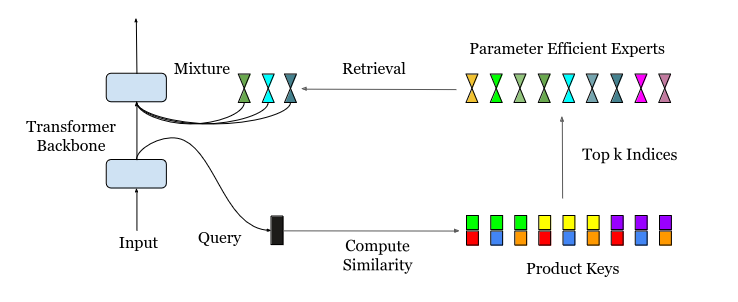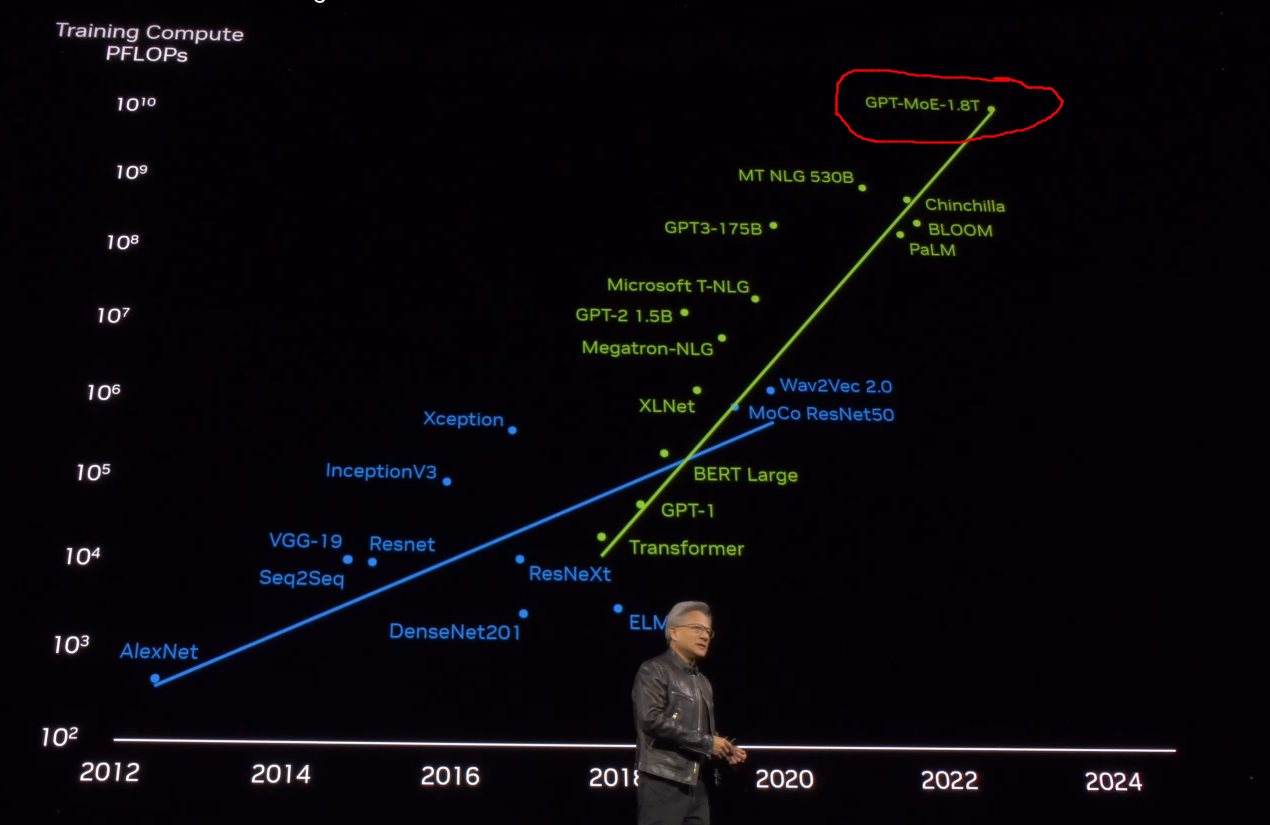Track
For years, scaling AI models mostly meant adding more parameters and training data.
While this approach improves performance, it also significantly increases computational costs. Mixture of Experts (MoE) has emerged as a promising solution to address this challenge, using sparsely activated expert modules instead of traditional dense feed-forward layers.
MoE functions by delegating the tasks to different experts based on their expertise in the topic. Each expert is heavily trained on a specific dataset to serve a particular purpose, and another component, the gating network, is responsible for delegating these tasks.

While MoE models outperform traditional models with Feed-Forward Layers, their efficiency can plateau as the model size grows due to the limitations of using a fixed number of training tokens.
Addressing this issue requires high-granularity architectures with a large number of experts. However, the only existing architecture supporting over ten thousand experts, the Mixture of Word Experts (MoWE), is language-specific and relies on a fixed routing scheme.
The Mixture of A Million Experts (MoME), introduced in this paper, tackles this challenge by introducing the Parameter Efficient Expert Retrieval (PEER) architecture, which employs product key retrieval for efficient routing to a vast number of experts.
Become an ML Scientist
Understanding PEER: The Power of Parallel Experts
One of the major challenges in scaling LLMs lies in the computational and memory demands of feedforward layers within transformer blocks. MoE addresses this by replacing these layers with sparsely activated expert modules, each specializing in different aspects of the task. This approach enhances efficiency by activating only relevant experts for a given input, reducing computational overhead.
Current approaches to MoE have limitations, such as fixed routers that need to be readjusted when new experts are added. So, a new approach to routing is introduced, replacing the fixed router with a learned index.
Parameter Efficient Expert Retrieval (PEER) reduces the number of active parameters in the MoE layer, affecting computation and activation memory consumption during pre-training and inference.
PEER demonstrates that by applying the right retrieval and routing mechanisms, MoE can be scaled to millions of experts, reducing the cost and complexity of training and serving very large language models.

In the diagram above, the input query initially undergoes product key retrieval to identify the top k experts. These selected experts then process the input based on their specialized knowledge, and their outputs are combined during the inference phase to generate the final model output.
Mixture of Million Experts: The Technical Details
PEER's core innovation is the use of product key retrieval. The goal remains the same as in traditional MoE: finding the top k experts best suited for the given task. However, with a vast number of experts (potentially exceeding a million), the previous techniques become computationally expensive or inefficient.
Consider a scenario with N experts, each represented by a d-dimensional vector. Computing the top k experts directly would involve calculating the similarity between the input query and all N expert keys, resulting in a time complexity of O(Nd). When N is very large (e.g., N ≥ 10^6), this becomes prohibitively expensive.
PEER addresses this by employing a clever strategy: instead of using N independent d-dimensional expert keys, it splits each key into two independent subsets, each with dimensionality d/2. Similarly, the query vector is divided into two sub-queries. The top-k operation is then applied to the inner products between these sub-queries and sub-keys.
This Cartesian product structure of the keys dramatically reduces the computational complexity from O(Nd) to O((N^.5+ k2)d), making it feasible to efficiently identify the top k experts even with a massive number of experts.
PEER Layer Architecture
The Parameter-Efficient Expert Retrieval (PEER) layer is an MoE architecture that uses product keys in the router and single-neuron MLPs as experts.
A PEER layer consists of three components:
- A pool of N experts E
- A corresponding set of N product keys K
- A query network q
Here is how it works:
- Given an input query x, retrieve a subset of k experts whose corresponding product keys have the highest inner products with the query q(x).
- Apply an activation function like sigmoid or softmax to obtain the router scores for these retrieved top k experts.
- Compute the output by linearly combining the expert outputs weighted by the router scores.
In essence, the PEER layer efficiently identifies the most relevant experts for a given input, allowing for the effective utilization of a massive number of experts while maintaining computational tractability. This innovation is a key enabler for scaling MoE models to millions of experts, paving the way for more powerful and efficient LLMs.
Advantages of the PEER Approach
PEER, in conjunction with the MoME architecture, offers several compelling advantages over traditional MoE approaches, pushing the boundaries of LLM capabilities:
- Improved efficiency: By utilizing a vast number of specialized experts, PEER enables more accurate and efficient retrieval of relevant information, leading to improved overall model performance.
- Lifelong learning: PEER facilitates continuous learning and model growth. New experts can be added incrementally, expanding the model's knowledge base without the need for complete retraining, thus preserving previously acquired knowledge.
- Scalability: PEER addresses the scalability limitations of traditional MoE architectures, enabling the development of trillion-parameter models like GPT-MoE-1.8T. This opens up new possibilities for creating even more powerful and capable LLMs.
Potential Applications of MoME
Mixture-of-Experts is already a widely used model paradigm in the industry, with companies like YouTube integrating it into their recommendation system. The future of MoME looks similar, and it was already hinted at in Nvidia's GTC 2024, when they talked about GPT’s 1.8 trillion model.

Mixture of Million Experts (MoME), with its PEER architecture, shows particular promise for complex NLP tasks requiring a broad knowledge base and rapid response retrieval. It addresses the scalability challenges inherent in training and serving very large language models, opening up new possibilities for their use in domains like computer vision, content generation, recommendation systems, and smart computing.
Challenges and Limitations
Scaling a model up to a million experts seems promising from an efficiency point of view but managing such a large network poses its challenges. Let’s explore some of them:
- Computational complexity and efficiency:
- Expert retrieval cost: Computing the top k experts from a pool of a million can be computationally expensive. Even with optimizations like product-key retrieval, managing the retrieval process efficiently remains challenging.
- Training overhead: Training such a large model with a massive number of experts requires substantial computational resources, which might not be feasible for all research labs or companies.
- Memory constraints:
- Activation memory: As the number of experts grows, the memory required to store activations and intermediate results during training and inference can become prohibitive.
- Parameter storage: Storing a million experts demands significant memory capacity, which can limit the deployment on resource-constrained devices.
- Regularization and stability:
- Overfitting: With such a large number of parameters, there is a risk of overfitting to the training data. Effective regularization techniques are crucial but can be challenging to design and implement.
- Stability: Training stability can be an issue, as managing gradients and updates for a million experts can lead to numerical instabilities and convergence problems.
Conclusion
In this article, we explored the Mixture of Million Experts (MoME) technique, a scalable approach for large language models.
MoME leverages specialized expert networks and the PEER routing mechanism to improve efficiency and performance.
We discussed its core components, benefits, and potential applications. For a deeper dive, refer to the research paper for technical details and benchmark results.
For more information, refer to the research paper for technical details and benchmark results.
Earn a Top AI Certification
Senior GenAI Engineer and Content Creator who has garnered 20 million views by sharing knowledge on GenAI and data science.


